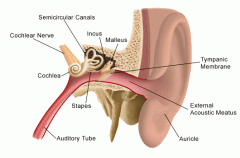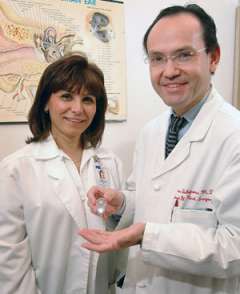Cochlear Implant Program
Overview
The Cochlear Implant Program at UCLA represents one of the largest and most prestigious cochlear implant centers in California and is well recognized across the country.

The program has been in existence since 1997 and has accumulated a wealth of experience and expertise providing quality medical care to close to 500 cochlear implant recipients, young and old. The number of patients implanted annually continues to rise as a result of expanding candidacy criteria for implantation as well as new developments in cutting-edge cochlear implant technology. The UCLA Cochlear Implant Program incorporates a knowledgeable and sophisticated team of scientists and healthcare professionals.
What is a Cochlear Implant?
A cochlear implant is a surgically implanted electronic device that provides a sense of sound to a person who is profoundly deaf or severely hard of hearing. An implant does not restore normal hearing. Instead, it can give a deaf person a useful representation of sounds in the environment and helps him or her to understand speech.
The implant consists of an external portion that sits behind the ear and a second portion that is surgically placed under the skin. The basic parts of the device include:
- A microphone that picks up sound from the environment
- A speech processor that selectively filters sound to prioritize audible speech and sends the electrical sound signals through a thin cable to the transmitter
- A transmitter, which is a coil held in position by a magnet placed behind the external ear; it transmits the processed sound signals to the internal device by electromagnetic induction.
- A receiver and stimulator secured in bone beneath the skin, which converts the signals into electric impulses and sends them through an internal cable to electrodes.
- An array of up to 22 electrodes wound through the cochlea, which send the impulses to the nerves in the scala tympani and then directly to the brain through the auditory nerve system.
According to the Food and Drug Administration (FDA), as of April 2009, approximately 188,000 people worldwide have received implants. In the United States, roughly 41,500 adults and 25,500 children have received them.
Candidates
UCLA determines implant candidacy on an individual basis and takes into account a person's hearing history, cause of hearing loss, amount of residual hearing, speech recognition ability, health status, and family commitment to aural habilitation/rehabilitation. The three main groups of people to receive implants are post-lingually deaf adults, pre-lingually deaf children and post-lingually hearing-impaired people whose hearing loss is usually due to disease.
A prime candidate has:
- severe to profound sensorineural hearing impairment in both ears
- a functioning auditory nerve
- lived at least a short amount of time without hearing (approximately 70+ decibel hearing loss, on average)
- good speech, language, and communication skills, or in the case of infants and young children, a family willing to work toward speech and language skills with therapy
Because of cochlear implantation is a rather delicate and challenging procedure patients should consider the experience and knowledge of the medical staff and clinical associates when selecting a cochlear implant center.
Procedure

- Pre-operative blood work and counseling with the medical staff.
- CT scan to review cochlear anatomy.
- Two- to three- hour surgery performed under general anesthesia. Surgery is performed on an outpatient basis with the possibility of an overnight stay or 23-hour observation period, depending on individual health concerns. The patient will not hea through the implant until it is activated during a follow-up appointment.
- Placement of a surgical bandage over the implant site to remain secure for a healing period of 5-7 days postoperatively. Hair washing should be avoided during this period.
- Return appointment to the UCLA Head and Neck Surgery clinic for bandage removal.
- Return appointment for implant activation. This appointment is scheduled approximately 2-3 weeks from the date of surgery.
- Post-operatively, all patients will be provided antibiotic medications as well as pain relievers, if needed.
- Restrictions on heavy lifting, straining and strenuous exercise will be imposed for approximately 1 month following implantation.
Ongoing Care
Post-operatively, patients maintain a close relationship with audiologists and speech pathologists for ongoing care while developing communication skills and getting used to life with cochlear implants. This patient care relationship along with active family involvement is important to ensure that speech and communication skills reach their full potential.
UCLA Cochlear Implant Outreach Program in Armenia
The Armenian International Medical Fund (AIM Fund) was formed in May of 2003 as a non-profit organization. Its mission is to create and maintain innovative healthcare programs in Armenia. One of the organizations' major endeavors is to provide free hearing screenings, low-cost hearing aids, and cochlear implant surgeries on children and young adults.
Based on the health care needs of the people of Armenia, AIM Fund will establish world-class services with dedicated multidisciplinary professionals and cutting edge technology, including the Armenian National Ear Center, Neurosurgery services and a Medical Student Exchange program.
Since 2004, the AIM Fund has helped 42 children and young adults undergo successful cochlear implant surgeries. Armenia has become the regional center for cochlear implants in the Caucasus and is second only to Russia in providing these services in the region. In June 2008, the Armenian government recognized this project as one of the most innovative government-supported healthcare programs in the country. The AIM Fund is operated solely by medical staff volunteers from the United States and Armenia.